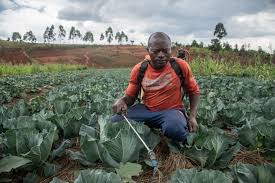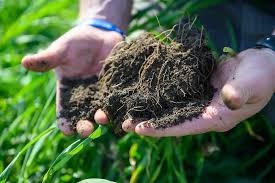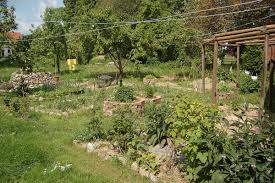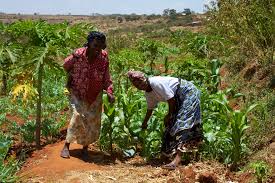Cropping systems for small farms play a vital role in enhancing productivity, sustainability, and resilience in agricultural practices. Smallholder farmers, who often manage limited land and resources, must adopt efficient cropping systems that maximize yields while minimizing environmental impact.
These systems are not just about planting and harvesting; they encompass a range of strategies that include crop rotation, intercropping, agroforestry, and conservation tillage. Each of these methods offers unique benefits that can lead to increased food security and improved livelihoods for farmers.
One of the key principles of successful cropping systems is diversity. By growing multiple crops rather than monocultures, small farmers can reduce the risk of crop failure due to pests, diseases, or adverse weather conditions.
For instance, intercropping where two or more crops are grown together can enhance soil fertility, improve pest management, and optimize the use of available resources such as light and nutrients.
This approach not only increases yield but also promotes biodiversity, which is essential for ecosystem health.
Crop rotation is another effective strategy that involves alternating different crops in the same field over time. This practice helps break pest and disease cycles, improves soil health, and enhances nutrient availability.
By planting legumes, which fix nitrogen in the soil, farmers can boost fertility for subsequent crops without relying heavily on chemical fertilizers.
This sustainable practice reduces input costs and promotes long-term soil health, which is crucial for small farms aiming for sustainability.
Agroforestry, which integrates trees and shrubs into crop systems, offers additional benefits. Trees provide shade, reduce soil erosion, and improve microclimates, creating a more favorable environment for crops.
They also contribute to biodiversity, enhance soil health, and provide additional income through timber or fruit production. This multi-layered approach can significantly increase the resilience of small farms to climate variability.
Conservation tillage is another essential practice that minimizes soil disturbance, preserving soil structure and moisture.
This method reduces erosion and enhances organic matter, leading to healthier soils.
For smallholder farmers, adopting conservation tillage can lower labor costs and improve yields over time.
The choice of cropping system often depends on various factors, including local climate, soil type, market access, and farmer preferences. Therefore, tailoring cropping systems to specific local conditions is critical.
Engaging with agricultural extension services, local cooperatives, or farmer groups can provide valuable insights into the most suitable practices and crops for small farms.
Additionally, the use of local knowledge and traditional practices can enhance the effectiveness of modern cropping systems, ensuring they are culturally relevant and economically viable.
The best cropping systems for small farms are those that promote sustainability, resilience, and productivity. By incorporating diverse practices such as intercropping, crop rotation, agroforestry, and conservation tillage, smallholder farmers can optimize their resources, improve soil health, and increase their yields.
As the global demand for food continues to rise, investing in effective cropping systems will be essential for supporting small farms and ensuring food security for future generations.
Importance of Cropping Systems for Small Farms

1. Enhanced Productivity: Cropping systems optimize land use, leading to increased yields and better resource management, which is crucial for small farms with limited space.
2. Soil Health Improvement: Diverse cropping systems contribute to soil fertility by promoting microbial activity, reducing erosion, and enhancing nutrient cycling, ultimately leading to healthier crops.
3. Pest and Disease Management: Integrating different crops helps break pest and disease cycles, reducing the need for chemical interventions and promoting a more balanced ecosystem.
4. Economic Viability: By diversifying crops, small farmers can access different markets, reduce financial risk, and improve income stability through multiple revenue streams.
5. Sustainability: Implementing cropping systems that focus on ecological balance and resource conservation supports sustainable practices, ensuring long-term viability for small farms.
6. Adaptation to Climate Change: Diverse cropping systems increase resilience to climate variability by spreading risk and enhancing the capacity to cope with changing environmental conditions.
Traditional vs. Modern Cropping Systems
1. Traditional Cropping Systems: Characterized by monoculture practices, reliance on local varieties, and limited technology, traditional systems often prioritize subsistence farming and local customs.
2. Modern Cropping Systems: Focus on high-yield varieties, precision agriculture technologies, and scientific management practices, modern systems aim to maximize production and efficiency.
3. Resource Use Efficiency: Modern systems utilize advanced technologies for irrigation, fertilization, and pest control, leading to better resource management compared to traditional methods.
4. Economic Considerations: While modern systems can offer higher yields and profitability, traditional systems often have lower input costs and are more accessible for small-scale farmers.
5. Environmental Impact: Traditional systems may have a smaller ecological footprint, but modern systems can implement practices that enhance sustainability and reduce environmental harm through improved management.
Crop Rotation: Benefits and Techniques
1. Benefits of Crop Rotation:
i. Pest and Disease Control: Rotating crops disrupts pest life cycles, reducing the prevalence of diseases and pests associated with specific crops.
ii. Nutrient Management: Different crops have varying nutrient requirements; rotation helps balance soil nutrients and reduces the risk of depletion.
iii. Weed Suppression: Changing crops can help suppress weed growth, as many weeds are adapted to specific crops.
iv. Soil Structure Improvement: Rotating deep-rooted and shallow-rooted plants enhances soil structure and prevents compaction.
2. Techniques of Crop Rotation:
i. Simple Rotation: Alternating two or more crops in a fixed pattern, such as planting legumes one season and cereals the next.
ii. Complex Rotation: Involves more crops and follows a planned sequence that may include cover crops or green manures.
iii. Intercropping: Planting two or more crops simultaneously in the same field, benefiting from complementary growth habits and resource use.
iv. Cover Cropping: Using cover crops in the off-season to improve soil health, prevent erosion, and enhance nutrient cycling before the main crop is planted.
Intercropping: Maximizing Space and Resources
1. Definition and Concept: Intercropping involves growing two or more crops in proximity within the same field, allowing for efficient use of space, sunlight, and nutrients.
2. Benefits of Biodiversity: By increasing plant diversity, intercropping enhances ecosystem resilience, improves pest management, and boosts pollinator activity.
3. Resource Utilization: Different crops often have varying root depths and nutrient needs, enabling them to access resources more efficiently and minimizing competition.
4. Reduced Pest Pressure: Diverse plantings can disrupt pest life cycles, reduce the spread of diseases, and attract beneficial insects that prey on pests.
5. Improved Soil Health: Intercropping can enhance soil structure and fertility through organic matter addition and reduced soil erosion.
6. Crop Yield Optimization: Combining crops that complement each other can lead to increased overall yields compared to monoculture systems.
Read Also: Everything You Need To Know About Spices Thai
Cover Cropping: Enhancing Soil Health

1. Soil Fertility Improvement: Cover crops, such as legumes, fix atmospheric nitrogen, enhancing soil fertility and reducing the need for synthetic fertilizers.
2. Erosion Control: By covering the soil, these crops help prevent erosion, especially on sloped terrains, and improve water retention in the soil.
3. Weed Suppression: Cover crops compete with weeds for resources, reducing their growth and minimizing the need for herbicides.
4. Habitat for Beneficial Organisms: They provide shelter and food for beneficial insects, earthworms, and microbes, promoting a healthy soil ecosystem.
5. Nutrient Cycling: Cover crops enhance nutrient cycling by incorporating organic matter into the soil, which supports healthy plant growth in subsequent crops.
6. Water Management: Cover crops help improve soil structure, increasing its ability to retain moisture and reducing the need for irrigation.
Organic Cropping Systems: Practices and Advantages
1. Definition and Philosophy: Organic cropping systems focus on natural processes and biodiversity, avoiding synthetic chemicals and genetically modified organisms (GMOs).
2. Soil Health Practices: These systems prioritize practices such as crop rotation, composting, and reduced tillage to enhance soil fertility and structure.
3. Pest and Disease Management: Organic systems utilize biological pest control, resistant varieties, and cultural practices to manage pests and diseases sustainably.
4. Environmental Benefits: Organic farming promotes biodiversity, improves water quality, and enhances ecosystem services, contributing to a healthier environment.
5. Market Demand and Premium Pricing: Organic products often command higher prices in the market, providing economic incentives for farmers to adopt organic practices.
6. Community and Health Focus: Organic farming emphasizes local food systems, community engagement, and healthier food options for consumers.
Read Also: Everything You Need To Know About Spices Thai
Permaculture Principles in Small-Scale Farming

1. Definition and Ethics: Permaculture is a design system that mimics natural ecosystems, integrating land, resources, and people to create sustainable agricultural systems.
2. Design for Diversity: Permaculture emphasizes biodiversity by integrating various plants and animals, creating a resilient ecosystem that can withstand environmental stresses.
3. Energy Efficiency: It promotes using renewable energy sources, such as solar and wind, to reduce reliance on fossil fuels in farming operations.
4. Water Management Techniques: Permaculture designs incorporate techniques such as swales, rainwater harvesting, and greywater reuse to manage water efficiently.
5. Soil Health Focus: Practices like mulching, composting, and using cover crops are essential to maintaining healthy soils and promoting nutrient cycling.
6. Community Involvement: Permaculture encourages community engagement and education, fostering local food production and self-sufficiency among farmers.
Agroforestry: Combining Crops and Trees
1. Definition of Agroforestry: Agroforestry is an integrated approach that combines agricultural crops with trees and shrubs to create a sustainable and productive farming system.
2. Biodiversity Enhancement: By incorporating trees, agroforestry increases biodiversity, providing habitats for wildlife and promoting a balanced ecosystem.
3. Soil Health Improvement: Trees contribute to soil fertility by adding organic matter through leaf litter, reducing soil erosion, and enhancing water retention.
4. Microclimate Regulation: The presence of trees helps regulate temperature and humidity, creating a more favorable microclimate for crops.
5. Economic Benefits: Farmers can diversify their income by producing multiple products, such as fruits, nuts, timber, and crops, which can reduce economic risk.
6. Carbon Sequestration: Agroforestry systems help capture carbon dioxide from the atmosphere, contributing to climate change mitigation.
Sustainable Practices in Cropping Systems
1. Conservation Tillage: Reducing tillage helps maintain soil structure, improve moisture retention, and minimize soil erosion, promoting healthier crops.
2. Crop Rotation: Rotating crops helps break pest and disease cycles, enhances soil fertility, and reduces the reliance on chemical inputs.
3. Integrated Pest Management (IPM): IPM combines biological, cultural, and chemical practices to manage pests sustainably, reducing environmental impact.
4. Use of Cover Crops: Cover crops improve soil health, suppress weeds, and enhance nutrient cycling, contributing to a more sustainable cropping system.
5. Organic Farming Practices: Emphasizing natural inputs and processes, organic farming promotes biodiversity, soil health, and environmentally friendly pest management.
6. Water Management Techniques: Sustainable practices include efficient irrigation systems, rainwater harvesting, and maintaining soil moisture to support crop growth.
Challenges in Implementing Cropping Systems
1. Initial Costs and Investment: Transitioning to sustainable cropping systems can require significant upfront investment in new technologies, equipment, and training.
2. Knowledge and Expertise: Farmers may need additional training and knowledge to effectively implement sustainable practices, which can be a barrier in some regions.
3. Market Access and Demand: Limited access to markets or low demand for sustainably produced crops can discourage farmers from adopting new systems.
4. Weather Variability: Climate change and unpredictable weather patterns can impact the success of cropping systems, affecting yields and crop viability.
5. Pest and Disease Management: New cropping systems may introduce unfamiliar pest and disease dynamics, requiring ongoing adaptation and monitoring.
6. Land Use Conflicts: Competing land use interests, such as urbanization or industrial development, can limit the available land for sustainable cropping practices.
Do you have any questions, suggestions, or contributions? If so, please feel free to use the comment box below to share your thoughts. We also encourage you to kindly share this information with others who might benefit from it. Since we can’t reach everyone at once, we truly appreciate your help in spreading the word. Thank you so much for your support and for sharing!
Read Also: How to Deal with Business Challenges: Strategies for Success

